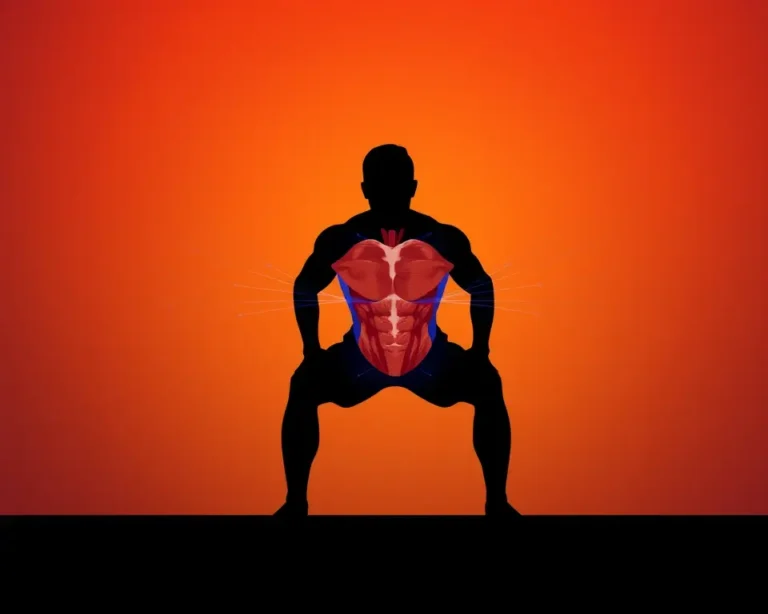Squats are a cornerstone of any effective fitness regimen, lauded for their ability to build lower body strength, improve athletic performance, and even contribute to core stability. But are you truly maximizing the benefits of this exercise? Often, the key to a more effective squat lies not in adding more weight, but in refining your core engagement.
Why Core Engagement Matters in Squats
The core acts as the body’s stabilizer during a squat. It helps maintain a neutral spine, prevents energy leaks, and allows you to lift heavier weights with proper form. Neglecting core engagement can lead to:
- Lower back pain
- Instability and wobbly movements
- Reduced power output
- Increased risk of injury
The Change: Master the Valsalva Maneuver
The single most impactful change you can make to your core engagement during squats is mastering the Valsalva maneuver. This technique involves taking a deep breath, holding it, and bracing your core muscles as if you’re about to be punched in the stomach.
What is the Valsalva Maneuver?
The Valsalva maneuver increases intra-abdominal pressure (IAP), creating a rigid cylinder around your spine. This cylinder provides support and stability, allowing you to maintain a neutral spine and transfer force more efficiently.
How to Perform the Valsalva Maneuver During Squats: A Step-by-Step Guide
- Set Your Stance: Stand with your feet shoulder-width apart, toes slightly turned out.
- Take a Deep Breath: Before you begin your descent, take a deep breath into your belly, not your chest. You should feel your abdomen expand.
- Hold Your Breath: Close your mouth and nose and hold the air in.
- Brace Your Core: Simultaneously, contract your abdominal muscles, obliques, and lower back muscles as if you are preparing to receive a punch. Imagine tightening a weightlifting belt around your midsection.
- Descend into the Squat: Maintain this core bracing and controlled breathing as you lower into your squat.
- Exhale Strategically: As you begin to ascend from the squat, release your breath in a controlled manner. Avoid exhaling all at once. A good strategy is to exhale slowly and forcefully through pursed lips, like you’re blowing out a candle.
- Repeat: Reset at the top by taking another deep breath and bracing your core before the next repetition.
Why This Works
- Increased Stability: The IAP created by the Valsalva maneuver stabilizes the spine, reducing the risk of injury, especially when lifting heavy weights.
- Improved Force Transfer: A stable core allows for more efficient transfer of force from your lower body to the barbell, enabling you to lift more weight.
- Enhanced Muscle Activation: Bracing your core activates a wider range of muscles, contributing to overall strength and stability.
Common Mistakes and How to Avoid Them
- Breathing into the Chest: Make sure you are breathing into your belly, not your chest. Chest breathing doesn’t create enough IAP.
- Forgetting to Brace: Holding your breath is not enough. You must actively brace your core muscles to create a rigid cylinder around your spine.
- Exhaling Too Early: Maintain the core brace and controlled breathing throughout the entire squat. Exhaling too early can compromise your stability.
- Exhaling Too Much: Avoid fully exhaling. Release air slowly to maintain IAP.
- Using a Weightlifting Belt Incorrectly: A belt can enhance the Valsalva maneuver, but it should not be used as a substitute for proper core engagement. Ensure you are still actively bracing your core against the belt.
Beyond the Valsalva Maneuver: Additional Core Engagement Tips
While the Valsalva maneuver is a game-changer, here are other tips to further enhance your core engagement during squats:
Rib Cage Position
Focus on “setting the ribs,” maintaining a neutral rib cage position throughout the squat. Avoid flaring your ribs up or letting them sag down. This helps maintain optimal alignment and core engagement.
Anti-Rotation
Think about resisting any twisting or rotating forces during the squat. This will further engage your obliques and other core muscles responsible for stability.
Foot Placement and Weight Distribution
Maintain even pressure throughout your feet, sometimes called foot tripod. Imagine a triangle on the sole of your foot, with pressure placed equally in three areas: on the front of the foot right behind the big toe, on the front of the foot behind the pinky toe, and on the heel.
Squat Variations
Certain squat variations can emphasize core engagement:
- Front Squats: Holding the weight in front of your body forces your core to work harder to maintain an upright position.
- Overhead Squats: Holding the weight overhead requires significant core stability and control.
- Goblet Squats: Holding a dumbbell or kettlebell in front of your chest can also improve core engagement.
Integrating Core Work Into Your Routine
To further improve your core strength and stability, incorporate dedicated core exercises into your routine:
- Plank: A classic exercise for building isometric core strength.
- Dead Bug: A great exercise for learning to engage your core while maintaining a neutral spine.
- Pallof Press: An anti-rotation exercise that strengthens the obliques.
- Russian Twists: A dynamic exercise that targets the obliques and abdominal muscles.
Listen to Your Body
As with any exercise technique, it’s essential to listen to your body and gradually increase the intensity and weight as you become more comfortable with the Valsalva maneuver. If you experience any pain or discomfort, stop and consult with a qualified healthcare professional or certified personal trainer.
The Bottom Line
By mastering the Valsalva maneuver and focusing on consistent core engagement, you can transform your squats into a more effective, safer, and powerful exercise. This single change can unlock new levels of strength, stability, and overall fitness. So, the next time you step under the barbell, remember to breathe, brace, and squat with intention.







